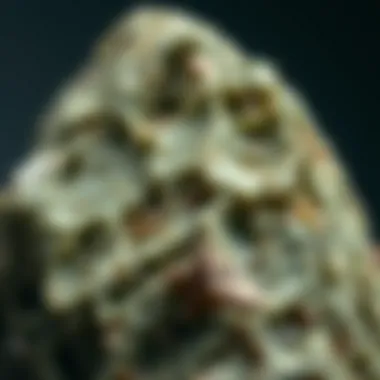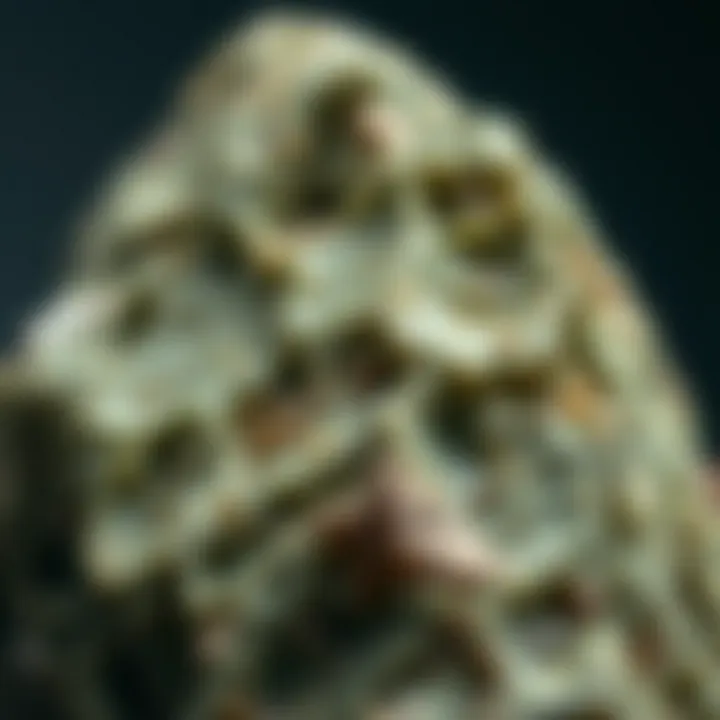Understanding Greenish Rock: Geological and Aesthetic Perspectives


Intro
Greenish rocks, with their captivating hues and intriguing origins, serve as fascinating subjects for both avid collectors and geology enthusiasts alike. But what exactly lies beneath their surface? This exploration reveals their geological formation, aesthetic appeal, and cultural footprint, all while enticing curiosity about their place in the natural world.
Given their diverse types and origins, each greenish rock can share a story that is as unique as the rock itself. From prized collectibles to foundational elements of the Earth’s crust, understanding these rocks offers insights not just into geology but into art and history as well. Therefore, whether you are a seasoned collector or a curious novice, there's always something new to learn when you delve into the world of greenish rocks.
Foreword to Greenish Rock
The focus on greenish rock is not merely a niche inquiry but rather a significant venture into understanding how these geological wonders intertwine with our lives. Greenish rocks can often be the unsung heroes of the geological landscape, holding key insights into both Earth's history and our human expression through art and design. They serve as reminders of the dynamic processes that shape our planet, manifesting beauty in diverse forms that attract the eye and provoke thought.
When we think of rocks, typically, we envision brown earth hues or gray stone—a palette that seems decidedly unremarkable. However, greenish rocks add a splash of color and curiosity that can inspire both laypeople and experts alike. The importance lies not just in their physical properties, but also in their broader implications for culture and individual expression. From the depths of geological processes to the hands of artists, each stone has a story to tell.
Defining Greenish Rock
Greenish rocks are classified primarily based on their predominant mineral composition and coloration. The green tint usually arises from significant amounts of minerals such as olivine, amphibole, or chlorite. These minerals infuse the rock with distinctive hues that can range from subtle mossy greens to striking emerald shades.
For example, an igneous rock like basalt can display greenish tints due to olivine crystals interspersed throughout its matrix. Alternatively, sedimentary formations may acquire green coloration from environmental conditions or the presence of organic materials. It is also important to note that these rocks often exhibit varying textural features—some can be coarse-grained while others might appear fine-grained, further complicating their categorization.
Historical Perspectives on Green Rocks
Exploring historical perspectives regarding green rocks can illuminate their diverse roles throughout various cultures. In ancient civilizations, such as Mesopotamia and Egypt, green substances were often associated with life and fertility, partially due to their prevalence in the landscape. The early Egyptians venerated minerals like green faience, which was a glass-like material that symbolized verdant renewal and was frequently used in ornamental artifacts and burial practices.
As time progressed, green stones found utility not just in aesthetics but in practicality. The stone jade, cherished by Chinese cultures, underwent an evolution of meaning—from a symbol of status to a material imbued with protective properties considered vital for harmonizing energies. Other peoples, including Indigenous groups, have celebrated earthy yet vibrant green stones, perpetuating stories through their use in tools and ceremonies.
In modern times, collectors have grown keen on the beauty and unique characteristics of greenish rocks, turning their historical significance into contemporary appreciation. People are not only drawn to their vibrant colors but also their history, which helps promote curiosity and a sense of connectedness to our geological and cultural pasts.
"Greenish rocks embody a narrative that spans eons, reminding us that the colors of our world tell stories beyond mere aesthetics."
Overall, greenish rocks serve a multifaceted purpose that goes beyond surface-level allure. They possess intrinsic value that has evolved through geological events and cultural reinterpretations, making them a significant subject of investigation and appreciation.
Geological Formation of Greenish Rock
Understanding the geological formation of greenish rock is essential for grasping not only its physical characteristics but also its broader ecological and aesthetic significance. Geological formation provides insights into how these vibrant stones come about and what they reveal about Earth’s history. In this section, we will delve into the fundamental attributes of mineral composition and the various processes that contribute to the formation of greenish rocks.
Mineral Composition
Silicate Minerals
Silicate minerals are the building blocks that reign supreme in the world of greenish rock. They consist mostly of silicon and oxygen atoms, creating a framework that is incredibly versatile. One prominent aspect of silicate minerals is their abundance on Earth, which accounts for over 90% of the planet's crust. This characteristic makes them a natural choice for the discussion of greenish rocks.
Key Characteristics
One of the defining traits of silicate minerals is their crystalline structure, which can vary significantly based on the environmental conditions during formation. This variability leads to a wide range of colors and textures, particularly appealing in greenish variants, like olivine.
Silicate minerals can be both strong and visually striking, making them popular in geological discussions.
Unique Features
A unique feature of silicate minerals lies in their capacity to form during diverse geological events such as volcanic eruptions or the gradual cooling of magma. The advantages of this include the formation of spectacular crystal formations that are highly sought after by collectors. However, some silicates can react negatively in certain environmental settings, making their preservation a challenge.
Mafic and Felsic Rocks
Mafic and felsic rocks play crucial roles in the classification and study of greenish rock types. The distinction between the two primarily lies in their silica content. Mafic rocks, rich in iron and magnesium, are typically darker and denser. Felsic rocks, on the other hand, contain a higher concentration of feldspar and quartz, leading to lighter hues.
Key Characteristics
The key characteristic of mafic rocks is their relative density, which comes from their heavy mineral content. This makes them resistant to erosion, allowing for their striking presence in various landscapes. Felsic rocks are generally more associated with granitic compositions, lending them a more varied aesthetic appeal.
Both categories result in unique greenish varieties, presenting opportunities for collectors to add distinct pieces to their collections.
Unique Features
Mafic rocks are notable for their rapid cooling rates, often resulting in smaller crystals, while felsic rocks cool more slowly, allowing for larger crystal growth. These features contribute significantly to their aesthetic allure. On the downside, however, the abundance of mafic rocks in some areas may overshadow the rarer felsic varieties.
Formation Processes
Igneous Processes
The formation processes of greenish rocks are primarily categorized into igneous, sedimentary, and metamorphic processes. Focusing on igneous processes, we see how both volcanic and intrusive formations lead to the birth of greenish rock.
Key Characteristics
During igneous processes, molten rock cools and solidifies, either above or below the Earth’s surface. This creates a variety of textures and compositions, often including vibrant green shades through minerals such as olivine. The faster the cooling, the smaller the crystals that form, while slow cooling allows for larger, more beautiful crystals to develop.
Unique Features
The unique feature of igneous formation is the dynamic environments in which these rocks form. Volcanic eruptions can spew ash and lava, creating dramatic landscapes filled with vibrant minerals. However, the rapid cooling can also result in glassy textures, which may not appeal to all collectors.
Metamorphic Transformation
Metamorphic transformation is another vital process in the formation of greenish rocks. This process involves the alteration of existing rocks due to high temperature and pressure, leading to the formation of minerals not found in the original rock.
Key Characteristics
One key characteristic of metamorphic rocks is their foliated texture, often resulting in a layered or banded appearance. The unique alterations in mineral composition can lead to formations with distinct green shades, such as those found in serpentinite.
Unique Features
Metamorphic rocks offer collectors an insight into the transformative processes of the Earth's crust. They highlight the dynamism of geological activity. However, the altered state can often result in instability, making these rocks more susceptible to weathering than their igneous counterparts.


Types of Greenish Rocks
When venturing into the domain of greenish rocks, understanding the various types is not just a curiosity but a necessity for any serious collector or aficionado. Each type holds a trove of geological secrets and aesthetics that can enrich one’s appreciation of not only the rock itself but also the Earth’s history.
In this section, we will delve into the primary varieties of greenish rocks, focusing on their unique characteristics, benefits, and considerations for collectors.
Olivine and Its Variants
Olivine is a standout when discussing greenish rocks, often found in the mantle of the Earth. Its vibrant, glassy green hues result from a high magnesium and iron content, which makes it an attractive specimen for collectors. This mineral not only captivates the eye but also plays a fundamental role in understanding the Earth's fiery interior.
Key Points about Olivine:
- Crystal Structure: Olivine crystallizes in a orthorhombic system, a fact that helps identify its distinct shape.
- Variants: There are several varieties of olivine, the most notable being forsterite (high in magnesium) and fayalite (high in iron), each with different shades of green.
- Formation: It primarily forms in volcanic rocks such as basalt, making it a key player in igneous geology.
Collectors often seek out this mineral not only for its beauty but also for its indicator role in volcanic activity. Besides just sitting on a shelf, olivine can symbolize the dynamic forces shaping our planet.
Greenstone and Its Characteristics
Greenstone is a term often used to describe metamorphosed volcanic rocks, primarily composed of amphibole and chlorite. Their rich greens result from the alteration of original minerals under heat and pressure, providing insight into tectonic processes.
Noteworthy Attributes of Greenstone:
- Appearance: Greenstone often exhibits a mottled and layered appearance, making each specimen unique and desirable for display.
- Composition: It mainly consists of minerals like chlorite, actinolite, and epidote, which together give it its characteristic green color.
- Geological Significance: Greenstones can be indicators of ancient tectonic activity, often found in regions with complex geological histories.
Many geologists pay particular attention to these types of stones because they reveal a lot about past geological environments, thus reinforcing the connection between nature’s artistry and scientific inquiry.
Serpentine and Its Uses
Serpentine, with its waxy, green hues, often draws attention both in geological circles and among jewelers. This mineral group is primarily formed through the alteration of olivine and pyroxene-rich rocks in environments that are rich in water and silica, usually in subduction zones.
Distinct Features of Serpentine:
- Types: Common varieties include chrysotile and antigorite, each presenting different shades of green and textures.
- Applications: Beyond its aesthetic appeal, serpentine is mined and used in talc products because of its softness and thermal resistance.
- Culturally Significant: In various cultures, serpentine is believed to bring healing properties, elevating its status not just as a mineral but as a talisman.
Collectors value these stones not only for their beauty but for their various applications, from home decor to artistic jewelry design.
"These greenish rocks not only provide insight into the Earth’s processes but also lend a unique aesthetic that is deeply rooted in geology and culture alike."
As we journey through the world of greenish rocks, it becomes clear that their significance transcends mere geology, embodying values that resonate with both collectors and casual enthusiasts. This multifaceted nature of greenish rocks enriches our understanding of the natural world and complements our appreciation for its beauty.
Physical Properties and Identification
Understanding the physical properties of greenish rocks is crucial for both collectors and enthusiasts. It aids in accurately identifying these stones while enhancing appreciation for their uniqueness. Physical properties serve as the foundation from which we assess a rock’s origin, quality, and potential uses. Without grasping these characteristics, examining greenish rocks becomes a shallow experience, limiting one’s true connection to the geological wonders they represent.
Color Variations and Textures
Luster
Luster in greenish rocks refers to how light interacts with the surface. It can be described as shiny, dull, or somewhere in between. The luster often reflects the mineral content within the rock. For instance, since many greenish rocks consist of minerals like olivine or serpentine, their luster can range from glassy to earthy.
The key characteristic of luster is that it can help quickly gauge a rock’s mineralogy. This is a beneficial trait for any collector. A shiny surface often indicates a high degree of purity in minerals, which can sometimes contain trace elements leading to the green coloration. An example is the bright, glasslike luster of some olivine varieties that attracts attention due to their vividness.
However, one must note its unique feature—luster can sometimes be deceptive. A rock may appear glossy but could still be fragile due to its mineral structure. Thus, while looking at luster provides a visual guideline, collectors should remain skeptical and conduct further tests to understand the rock’s overall durability.
Grain Size
Grain size describes the dimensions of the individual crystals or particles within a rock. In greenish stones, grain size can vary widely, from coarse-grained varieties like some greenstones, which feature visible crystals, to fine-grained ones where the individual grains can be hard to distinguish.
One important key characteristic of grain size is that it reflects the cooling history of the rock. For example, fast-cooling igneous rocks tend to have a finer grain size, while slow-cooling ones exhibit coarser grains. This feature is crucial; it helps identify the rock’s formation environment.
One particular advantage of knowing the grain size is its connection to rock strength. Generally, coarser grains can lead to stronger rocks, while finer grains may indicate potential fragility. Thus, identifying grain size can guide collectors in choosing stones that not only look good but also endure the test of time.
Hardness and Durability
Hardness refers to a mineral’s resistance to scratching, a property that is often gauged using the Mohs scale, which ranks minerals based on their hardness. For collectors, understanding hardness is pivotal, as it influences the practicality of these rocks in various applications, from construction to art.
The hardness of greenish rocks often arises from their mineral composition. For example, rocks rich in quartz tend to be quite durable, while those containing softer minerals like talc can easily be scratched. This durability can affect how well a stone holds up in jewelry or decor, thus directly impacting its appeal in the market.


Overall, recognizing the hardness of greenish rocks empowers collectors to make informed decisions on what to invest in. A gemstone that may turn out to be soft won’t hold its value compared to a hardier counterpart, thus enhancing the buyer's regret if care isn't taken from the outset.
The Aesthetic Appeal of Greenish Rock
The appeal of greenish rock stretches far beyond its geological origins; it resonates with human curiosity and creativity. This section dives into the aesthetic elements of greenish rock, emphasizing cultural significance and its incorporation in artistic and design contexts. Understanding its beauty requires an exploration of how these rocks have inspired designs and art for countless generations.
Cultural Significance
Uses in Art
The incorporation of greenish rock in art is a fascinating aspect, showcasing both the material's versatility and its alignment with natural themes. Greenish rocks, like jade or serpentine, often find their way into sculptures and decorative objects due to their vibrant colors and unique textures, enhancing the visual appeal of any creation.
For artists, these rocks provide an opportunity to connect the modern world with the ancient, creating pieces that tell stories from both time periods. A painter, for instance, could use green hues derived from these rocks to evoke feelings of tranquility and connection to nature. The key characteristic here is the way these materials amplify the emotional resonance of the artwork. However, obtaining high-quality greenish rock can be tricky; sourcing it ethically adds another layer of importance.
Symbolism in Cultures
Greenish rocks are often laden with symbolism across various cultures. For many societies, the color green is associated with growth, prosperity, and harmony. The rich green of jade holds particular reverence in Chinese culture, where it symbolizes nobility and moral integrity. This unique feature gives greenish rocks a depth that many more conventional materials lack. Such symbolism makes them not just aesthetic choices but meaningful ones as well. In specific rituals or celebrations, these rocks might be used to convey hope and healing, enhancing their cultural significance. The downside? Their strong associations can sometimes pigeonhole their artistic use, limiting exploration within contemporary contexts.
Incorporation in Design
Home Decor
When it comes to home decor, greenish rocks add a touch of elegance and a nod to nature’s rugged beauty. Their colors range from deep emerald to soft pastels, providing a palette that fits well in various interior designs. One of the main joys of using greenish stone in decor is its adaptability—whether used as a countertop, a backsplash, or even in smaller decorative elements like coasters or vases. Such versatility makes these materials a favorable option when looking to add a natural yet sophisticated touch to a space. However, the weight and fragility of some greenish rocks can pose challenges during installation, necessitating careful consideration during design planning.
Jewelry Making
Jewelry making with greenish rock is ancient yet perpetually trendy. Gemstones like emeralds or jade have adorned humans for centuries, echoing tales of romance, valor, and spirituality. Craftsmen often incorporate these stones into various forms, from necklaces to earrings, often combined with gold or silver to accentuate their natural beauty. The key characteristic lies in their ability to transform from raw stones to polished gems, captivating wearers with their inherent charm. While they are undoubtedly captivating, the sourcing of these stones should be approached ethically, as sustainability becomes an essential part of the luxury market. Not all greenish rocks are created equal; some may suffer from availability issues that can drive up costs, potentially limiting access for independent artisans.
The aesthetic appeal of greenish rocks transcends their mere physical properties, inspiring creativity, enriching traditions, and bringing nature's beauty closer to human experience.
Through understanding and appreciating the aesthetic aspects of greenish rocks, we can better connect with both nature and art, celebrating the unique attributes that make these rocks valuable in multiple contexts.
Collecting Greenish Rocks
Collecting greenish rocks intrigues rockhounds worldwide. Beyond their captivating hues, these rocks serve as tangible links to Earth’s processes and history. Engaging in this pursuit can foster a deeper appreciation for geology and unveil stories that stones convey about the planet. However, this passion comes with responsibilities and considerations that every collector must understand.
Ethical Considerations
When collecting greenish rocks, the ethical dimensions cannot be ignored. One crucial aspect is respecting nature. Collectors should avoid sites that are sacred or where mining is restricted. Instead, seeking locations where collection is both legal and sustainable ensures that our geological heritage is preserved for future generations.
Additionally, it's essential to think about how removal of rocks can impact local ecosystems. Some areas are rich in unique geologic formations or habitats for wildlife. Collectors must consider whether their actions could harm these environments. Practicing leave no trace principles can help mitigate potential damage.
Ultimately, ethical collecting enhances one's experience, leading to a richer connection with nature.
Techniques for Successful Collecting
Being effective in collecting greenish rocks requires a bit of strategy and preparation. Here are several techniques that can significantly improve your chances of success:
Identifying Locations
To find greenish rocks, identifying the right locations is key.
Here, tools like geological maps and local geological surveys can prove invaluable. Specific areas known for their greenish minerals, like olivine-rich basalt or serpentinite deposits, often have geological features that guide collectors. Visiting local rock and mineral clubs or engaging with online communities can also help pinpoint these promising sites.
The characteristic of accessibility also matters. Popular sites might welcome rock collectors while less-known areas might offer solitude for the true enthusiast. Some places have strict regulations for collection, so understanding local laws is paramount. Always verify that collecting in a certain area is permitted.
Additionally, seasonal changes can affect visibility and ease of access. Spring and fall typically offer clearer conditions.
In sum, identifying the right locations is not just a practical step; it lays the groundwork for a rewarding collecting experience.
Field Tools
The success of a rock-collecting excursion largely hinges on the right field tools. Basic tools should include a sturdy rock hammer, a chisel, and safety goggles. These essentials enable collectors to extract samples efficiently while prioritizing safety.
Carrying a mesh bag or sturdy backpack is also recommended for transporting finds. Choosing lightweight options allows collectors to move freely, particularly in challenging terrains.
A field guide specific to greenish rocks can serve as both an educational resource and a handy reference during collection. Having visuals and descriptions at hand makes it easier to identify potential finds on site.
Furthermore, a compass or GPS device ensures that enthusiasts don’t lose their way, especially in less-charted zones. With the right tools, the collecting becomes not just a task but a pleasurable journey.


Remember, the goal is not just to gather but also to understand and appreciate these geological wonders.
Care and Preservation
Taking care of greenish rocks is not just about keeping them clean; it’s an investment in their future. Proper maintenance enhances their beauty and ensures these geological treasures endure. Regular care can prevent damage from environmental elements, while the right storage solutions extend their lifespan significantly. Collectors frequently overlook these aspects, but a few conscientious habits can make a world of difference in preserving their prized pieces.
Cleaning Techniques
When it comes to cleaning greenish rocks, the process should be approached with caution. Here are some effective methods:
- Gentle Rinsing: Use lukewarm water to rinse off dirt. Never use hot water, as it can affect the integrity of the rock.
- Soft Brush: A soft-bristled brush can help dislodge stubborn dirt without scratching the surface. Toothbrushes are a good option, as they are soft yet effective.
- Mild Soap: If a rock is particularly grimy, a mixture of lukewarm water and a few drops of mild soap can be used. Always rinse thoroughly afterwards to remove any soap residue.
- Avoid Harsh Chemicals: Chemicals can deteriorate or discolor the rock. It’s best to stick with natural methods.
For stones with delicate textures or formations, consider the method known as "dry cleaning." This involves using a soft cloth to wipe away dust without any moisture. This method is particularly effective for shiny surfaces that would otherwise be dulled by water.
"Attention to detail in cleaning today can prevent larger issues tomorrow, allowing collectors to appreciate their rocks for years to come."
In some cases, if the rock is embedded with fragile minerals, it’s wise to consult with a professional before attempting to clean it yourself.
Display and Storage Solutions
The way greenish rocks are displayed or stored can significantly impact their condition. Consider these strategies:
- Avoid Direct Sunlight: Ultraviolet light can fade the vibrant colors in greenish rocks. Store or display them in shaded areas to maintain their allure.
- Quality Display Cases: Use glass display cases to protect the stones from dust, moisture, and physical contact that could damage them. Cases should have UV-blocking glass for added protection.
- Breathable Storage: If you need to store rocks away, use breathable fabric bags instead of plastic ones. Plastic can trap moisture which may lead to unwanted corrosion or mineral growth.
- Elevation: When displaying, keep rocks elevated above floor level to avoid potential damage from foot traffic or cleaning activities. Shelves or wall mounts can highlight their beauty and keep them safe.
In the end, how you care for and preserve your collection reflects not just a hobby, but a deep appreciation for these natural wonders. Cultivating knowledge in care practices not only benefits the rocks but enriches your connection to the earth's geological history.
Greenish Rock in Scientific Research
Greenish rocks offer a pivotal lens through which scientists can explore significant geological phenomena. Understanding these rocks enriches our comprehension of Earth’s past while also presenting vital insights into current environmental conditions. This section seeks to shed light on their importancy by delving into their geological significance and their contributions to mineralogy.
Geological Significance
Studying Earth's History
Studying Earth's history through greenish rocks highlights their invaluable nature for geologists. One notable aspect is that many greenish stones, owing to their mineral makeup, serve as a record of geological time. For example, rocks formed in the Earth's mantle often contain olivine, a mineral that implies high-temperature environments. This characteristic allows researchers to reconstruct geological events, offering insights about how tectonic movements shaped our planet.
An important benefit of this study is its ability to illustrate the past environmental conditions under which these rocks were formed. By analyzing isotopes contained within the minerals, scientists can date events that are millions of years old, bridging gaps in our understanding of Earth’s evolution. Moreover, greenish rocks often show layering and fossil records, which can reveal the transitions between different geological eras. One could say they act like pages in a giant book, each telling a part of the complex story of our planet.
However, this exploration does come with challenges. The complexity of these rocks’ formation processes can complicate interpretations, often leading to debates within the geological community about timelines and events. Nevertheless, the unique features they present continue to attract the interest of researchers and rock-hounds alike.
Indicators of Environmental Conditions
Greenish rocks also serve as essential indicators of environmental conditions, playing a dual role in both geology and ecology. A prime example lies in their ability to signal volcanic activity; certain types of greenstone are formed in environments known for heightened geothermal activity, suggesting that these areas may be economically suitable for geothermal energy. The presence of specific minerals can hint at past volcanic eruptions and their scale, guiding researchers in hazard assessments today.
Furthermore, these rocks can reflect sedimentary processes, offering clues about past climates. For instance, the relationship between the minerals present and the fluid dynamics in which they formed can indicate shifts in temperature or precipitation patterns. This clarity is particularly significant in today’s climate research, helping scientists communicate the implications of climate change more effectively.
One unique feature here is how these rocks can contain residual traces of organisms. By analyzing these remains, researchers can make inferences about historical biodiversity and the specific environmental conditions that allowed certain organisms to thrive. Still, like any scientific endeavor, there are limitations; geological interpretations can sometimes be influenced by the researcher’s biases or incomplete data.
Contributions to Mineralogy
In the world of mineralogy, greenish rocks contribute significantly to our understanding of mineral formation and alteration processes. They often contain a wealth of data about how minerals interrelate under various conditions, expanding the field's knowledge base. Notably, greenish rock formations can be among the most diverse, featuring a range of minerals from light to dark shades of green.
These contributions are vital for both amateur mineral collectors and professional scientists striving for a deeper understanding of mineral properties. Additionally, greenish minerals, such as serpentine, may possess unique properties that hint at novel applications in technology or industry. Thus, they not only contribute to understanding Earth’s formations but also hold potential for practical uses that extend into advanced materials science.
In summary, the study of greenish rocks in scientific research opens doors to both historical insights and future applications, contributing to the broader discourse about our planet and the natural world.
"Every rock tells a story — but greenish rocks are particularly verbose, speaking of ages past, long-lost environments, and present-day possibilities."
For further in-depth reading, consider visiting resources such as Wikipedia for definitions and historical context, or consult geological databases at US Geological Survey for specific data regarding rock samples in your local area.
End
The significance of greenish rock extends far beyond mere aesthetics. It serves as a poignant reminder of our planet's dynamic processes—its formation, evolution, and enduring beauty. In this article, we unwrapped layers of meaning, both literal and metaphorical, surrounding these captivating rocks. Every greenish stone tells a story, weaving geological history with modern artistry and cultural heritage.
The Lasting Impact of Greenish Rock
When we consider the lasting impact of greenish rock, several aspects come to light. Firstly, the geological narrative that each rock carries is crucial. These formations are indicators of tectonic activity, volcanic events, and the shifting climates of yesteryears. Importantly, they can also reveal the Earth’s response to environmental changes over time. By studying them, we learn about Earth’s history in ways that might not be possible through written records alone.
In terms of aesthetic value, greenish rocks like olivine and serpentine find their way into homes, jewelry, and art. Their deep hues can evoke emotions and symbolize renewal, growth, and tranquility. Collectors appreciate them not only for their physical attributes but also for their capacity to connect to human cultures across different eras. A piece of greenstone in a collection doesn't just hold its weight in minerals; it encapsulates history, culture, and the natural world’s splendor.
"Each greenish rock we encounter can spark curiosity, fostering a deep respect for our planet and its resources."
From a practical perspective, the ethical collection, preservation, and study of greenish rocks can promote sustainable practices among collectors and enthusiasts alike. The conversation about how we source and utilize these geological treasures highlights the delicate balance between appreciation and exploitation. Therefore, the discourse around greenish rocks encourages not just appreciation but thoughtfulness regarding their impact on both environment and society.



